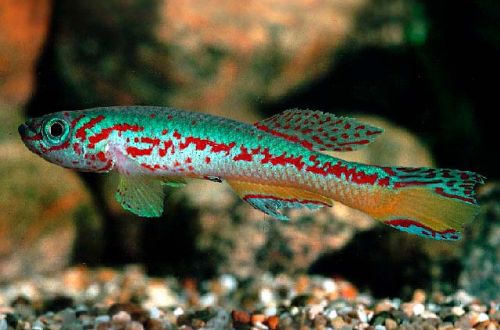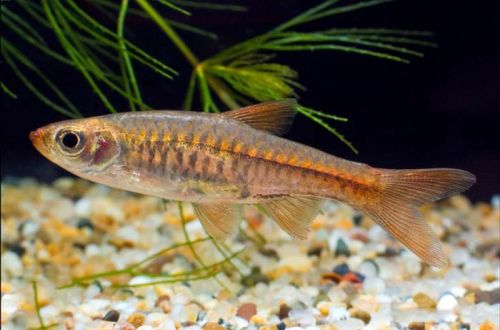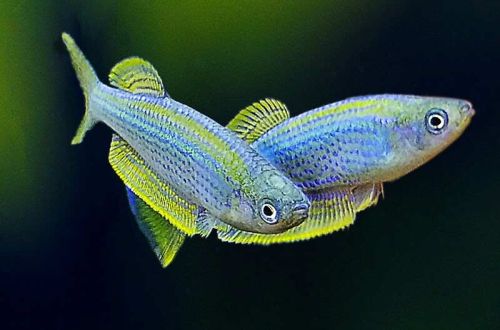
Afiosemion Amieta
Afiosemion Amieta, scientific name Fundulopanchax amieti, belongs to the family Nothobranchiidae (Notobranchiaceae). The fish is native to central Africa. Found in the Sanaga River basin in Cameroon. Inhabits swampy areas of streams and small rivers flowing under the canopy of tropical forest.

Contents
Description
Adult males reach a length of about 7 cm. They have a slender, elongated body with turquoise or greenish hues. The drawing consists of many bright red dots, combined into dotted lines. The fins are variegated with a similar ornament. The lower part of the body in the tail section, as well as the lower edge of the tail, are colored yellow.
Females are somewhat smaller in size. Unlike males, they do not have bright colors. The main color is silvery with a pale blue tint. There may be faint red dots.
A close relative of Afiosemion the South, who lives in a similar habitat.
Behavior and Compatibility
Peaceful shy look. In nature, they live in flocks, hiding among dense aquatic vegetation. For this reason, it is recommended to purchase a group of 4-5 individuals. Species aquarium is the most preferred. However, if desired, you can place several small fish of similar size, for example, Tetr, Rasbor, etc.
Brief information:
- The volume of the aquarium – from 40 liters.
- Temperature – 20-27°C
- pH value – 5.8 – 7.2
- Water hardness – soft (5-15 dGH)
- Substrate type – any dark
- Lighting – subdued
- Brackish water – no
- Water movement – little or no
- The size of the fish is up to 7 cm.
- Food – any food
- Temperament – peaceful
- Keeping a group of 4–5 individuals
- Life expectancy – 2-3 years
Maintenance and care, arrangement of the aquarium
The optimal size of the aquarium for a group of 4-5 fish starts from 30-40 liters. In the design, it is worth using a large number of aquatic plants, from covering the substrate to floating on the surface. Floating plants will create shade, so shade-loving ferns, mosses, anubias and others should be placed on the lower tiers. An additional decoration element will be natural driftwood and leaves of some trees (beech, oak, Indian almond, etc.) placed on a dark substrate.
The water parameters are predominantly acidic with low hardness. A slight increase in pH above neutral values is acceptable.
The aquarium must be equipped with a lid. Afiosemion Amieta is prone to jumping out of the water.
Being a native of swamps, the fish does not respond well to excess water movement. In this case, a simple airlift filter with a sponge is a good choice.
If the aquarium is located in a bright, warm room, then there is no urgent need for a lighting system and a heater.
Maintenance is standard and consists of the following mandatory procedures: weekly replacement of part of the water with fresh water (15–20% of the volume), removal of organic waste with soil cleaning.
Food
The details of the daily diet should be clarified with the supplier. Some fish can eat exclusively live and frozen food (brine shrimp, bloodworms, daphnia), while others are accustomed to alternative dry food.
Breeding / breeding
Experienced aquarists rate the breeding of Afiosemion Amieta as easy. The best results are shown by groups where the number of males is less than females. The optimal environment is water of medium hardness in the slightly alkaline pH range with a temperature of 20–23°C.
A diet high in protein, such as live food, stimulates the onset of the spawning state.
As a substrate or material that is placed on the ground, small-leaved clusters of moss, coconut fibers or artificial substitutes are used. After the fish lay eggs, the substrate is removed and placed in a separate tank with identical water conditions. The tank is placed in a dark place and is equipped with an airlift filter.
The incubation period can last from 6 to 8 weeks. The newly hatched fry require microscopic food such as brine shrimp nauplii, infusoria or specialized powdered food suspensions.
Sources: Fish Base, Encyclo-Fish.com, killi.co.uk





